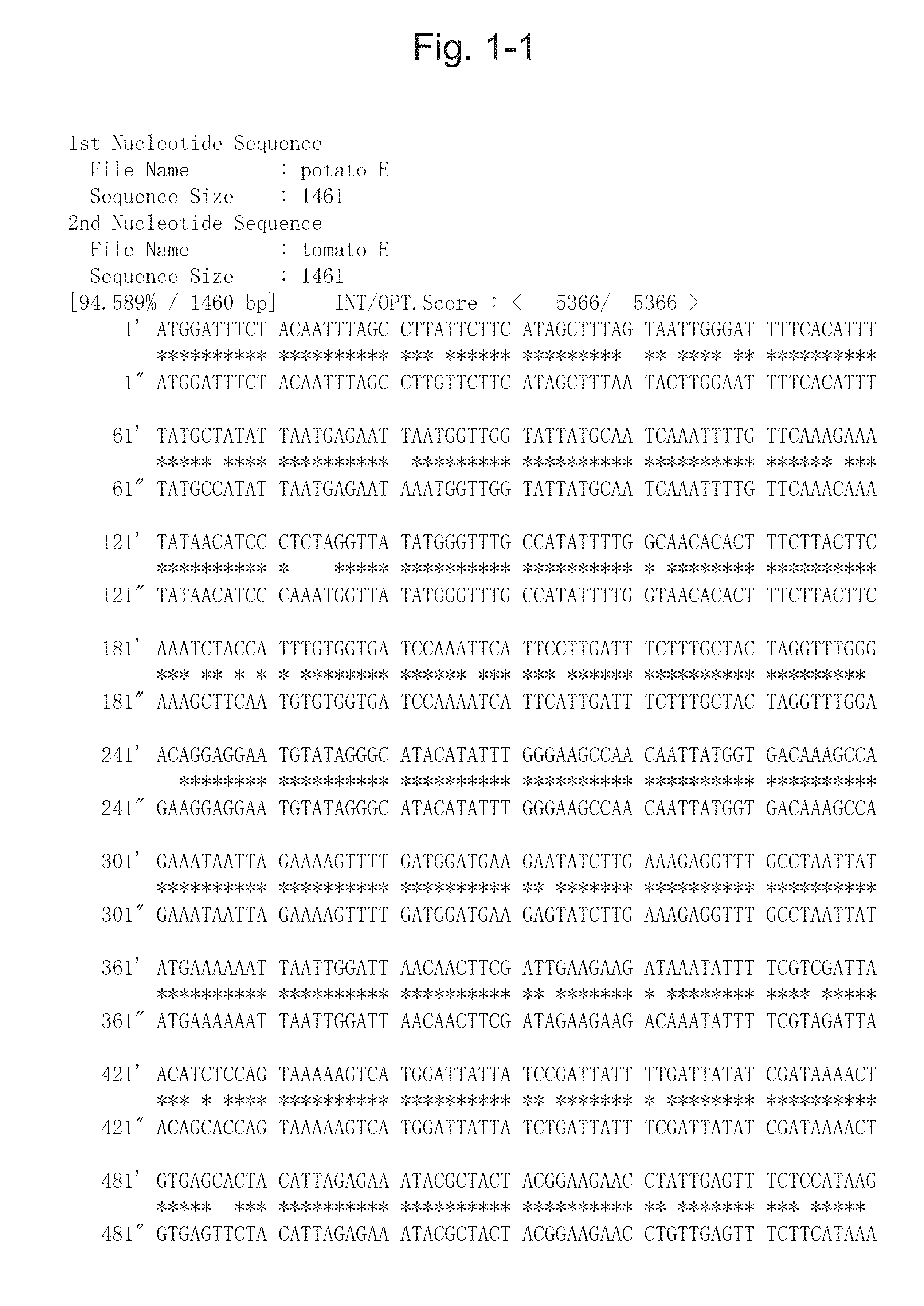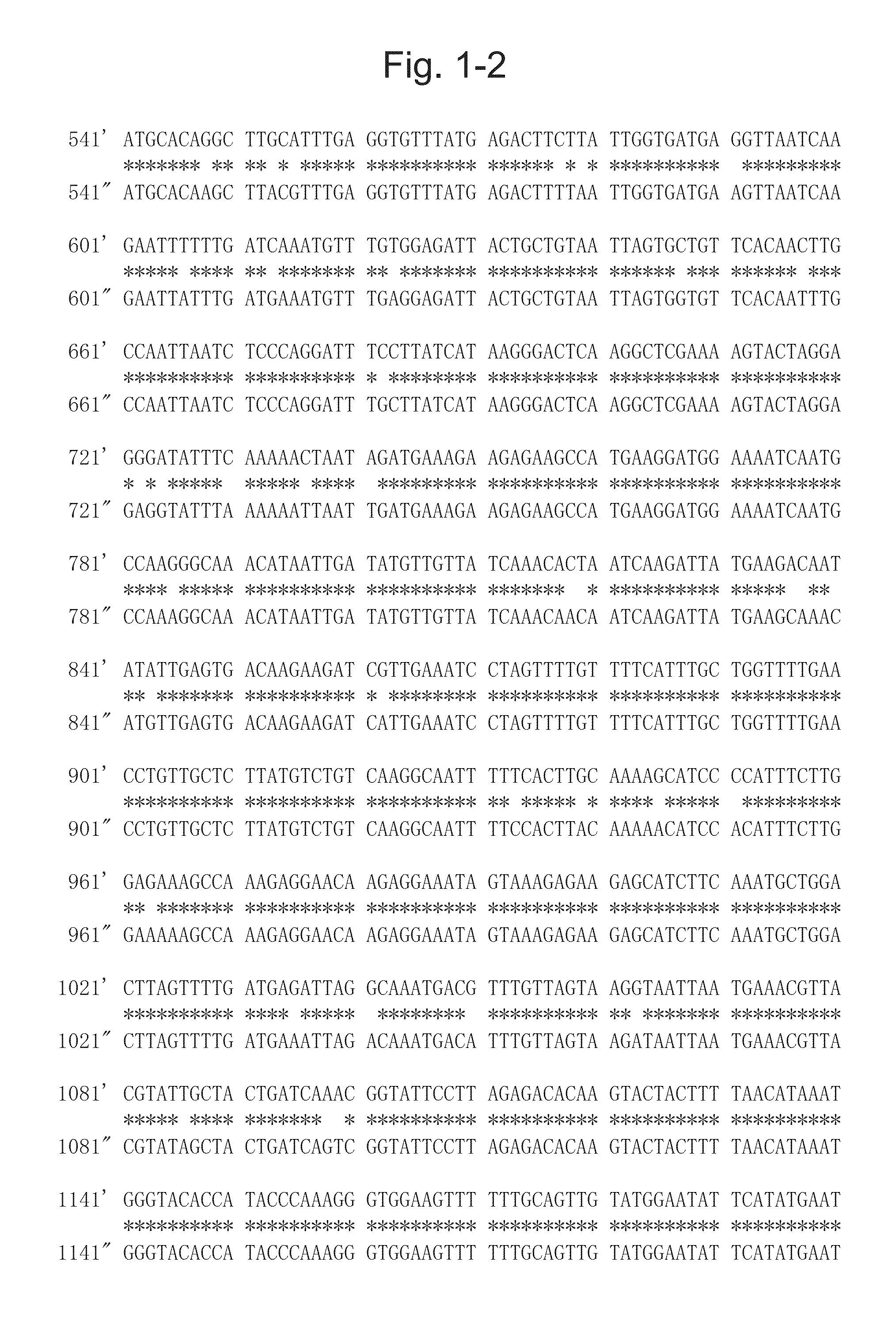Plant having suppressed expression of glycoalkaloid biosynthetic enzyme gene or altered activity of the enzyme
a biosynthetic enzyme and plant technology, applied in the field of plant having suppressed the expression of glycoalkaloid biosynthetic enzyme gene or altered can solve the problems of reducing glycoalkaloids, not being achieved, and hardly proceeding with research and development on suppressing metabolites or efficient production of them. , to achieve the effect of lowering the activity of the enzym
- Summary
- Abstract
- Description
- Claims
- Application Information
AI Technical Summary
Benefits of technology
Problems solved by technology
Method used
Image
Examples
example 1
Acquisition of Full-Length Sequence of Glycoalkaloid Biosynthesis Gene E
[0094]mRNA was extracted from the sprouts of the potato (Solanum tuberosum) variety “Sassy” (sold by Japan Agribio Company) using RNeasy (QIAGEN). Total cDNA was synthesized using SuperScript First-Strand System (Invitrogen). An aglycone of glycoalkaloids is said to be made of cholesterol, but there is no definitive evidence to indicate it (Non-patent literature 1). However, even when an aglycone is assumed to be produced from a related compound, some oxidation processes are still required therefor. At least the following 3 types of enzyme, cytochrome P450 monooxygenase, dioxygenase, and NADPH-flavin reductase may be involved in the oxidation processes. Of them, P450 monooxygenase was considered to be a target, and attention was given to TC155233 gene, for which many EST clones had been isolated from sprouts, based on the disclosed information, DFCI Potato Gene Index (http: / / compbio.dfci.harvard.edu / tgi / plant.ht...
example 2
Isolation of Genomic Gene of Glycoalkaloid Biosynthetic Gene E
[0097]Genomic DNA was extracted from “Sassy” using DNeasy (QIAGEN). PCR was performed using the same primers as in Example 1, U904 (TGATAAGGAAATCCTGGGAGA (SEQ ID NO: 8) and U901 (AGAGAAGCCATGAAGGATGG (SEQ ID NO: 9)). PCR was further performed for the 2nd intron using as an enzyme PrimeSTAR HS DNA Polymerase (TAKARA BIO INC.) and primers (U898: GAAATACGCTACTACGGAAGAACC (SEQ ID NO: 10) and U899: CGTCATTTGCCTAATCTCATC (SEQ ID NO: 11)). Thus, the nucleotide sequence of the full-length genomic DNA was determined (SEQ ID NO: 5). It was revealed that introns were present at 7 positions.
[0098]The genome sequence of the potato gene (Xu et al., Nature (2011) 475: 189-197) has been recently reported. The genome sequence is open to the public in HP (http: / / potatogenomics.plantbiology.msu.edu / index.html) of the Potato Genome Sequencing Consortium Data Release. It is possible to determine the genome of the gene E based on this sequence...
example 3
Construction of Vector for Creating Suppression Transformant of Glycoalkaloid Biosynthesis Gene E
[0099]As a method of suppressing the gene by transformation, the expression (commonly referred to as the RNAi method in plants) of the complementary strand gene fragment in the reverse direction having a structure driven by a strong promoter was performed [Chuang and Meyerowitz, Proc. Natl. Acad. Sci. U.S.A., 97, 4985-90 (2000), and Wesley et al., Plant J., 27, 581-90 (2001)]. PCR (conditions: 95° C. for 5 minutes, 30 cycles of 95° C. for 30 seconds, 55° C. for 30 seconds, and 72° C. for 30 seconds, followed by 72° C. for 10 minutes) was performed for the full-length cDNA obtained in Example 1 using primers [U675: GAGCTCTAGAGGTTTGGGACAGGAGGAAT (SEQ ID NO: 12) and U676: GGATCCATATGCAAGCCTGTGCATCTTAT (SEQ ID NO: 13)], thereby obtaining a gene fragment. The pKT230 vector for plant transformation (FIG. 2) was constructed by ligating the 35S RNA promoter of cauliflower mosaic virus, the gene ...
PUM
| Property | Measurement | Unit |
|---|---|---|
| pH | aaaaa | aaaaa |
| pH | aaaaa | aaaaa |
| photon flux density | aaaaa | aaaaa |
Abstract
Description
Claims
Application Information
 Login to View More
Login to View More - R&D
- Intellectual Property
- Life Sciences
- Materials
- Tech Scout
- Unparalleled Data Quality
- Higher Quality Content
- 60% Fewer Hallucinations
Browse by: Latest US Patents, China's latest patents, Technical Efficacy Thesaurus, Application Domain, Technology Topic, Popular Technical Reports.
© 2025 PatSnap. All rights reserved.Legal|Privacy policy|Modern Slavery Act Transparency Statement|Sitemap|About US| Contact US: help@patsnap.com



